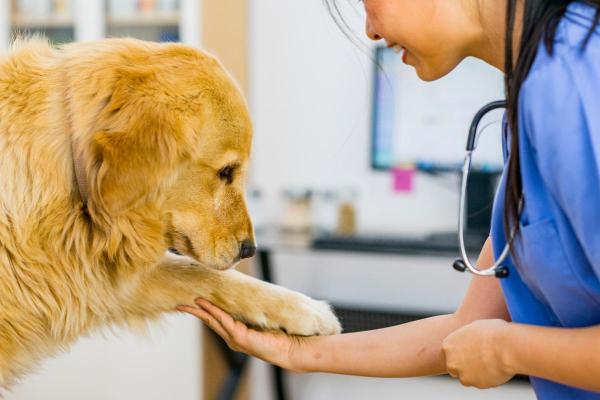My Dog Is Shaking and Acting Weird



See files for Dogs
The reasons why a dog is shaking and acting weird can be due to a range of causes which affect their nervous system. These problems also usually affect their appetite, meaning they stop eating. Although a dog may have localized issues which can cause them to shake or tremble, acting weird and not eating is usually a sign of a systemic problem. Knowing the causes of a dog shaking, acting weird and not eating can help us when relaying information to our veterinarian, but it important to note that only they can diagnose the issue.
At AnimalWised we find out why is my dog shaking and acting weird, as well as not eating. By looking at the most common causes of these symptoms, we can find out what possible treatment options are available.
Hypothermia
Hypothermia is the decrease in body temperature below healthy physiological limits. It occurs when the amount of heat lost is greater than the amount of heat produced by the body itself. In these cases, the dog is unable to thermoregulate themselves and their nervous system will begin to shut down.
Hypothermia is either due to excessive heat loss or a decrease in heat production by the dog's body. This can happen in one of two main ways:
- Very low environmental temperatures: it is especially frequent in puppies, because they have a lower capacity for thermoregulation.
- Pathological causes: such as hypothyroidism, terminal stages of disease, shock, sepsis and central nervous system lesions that affect the temperature regulating center.
Whatever the cause of hypothermia in dogs, when there is a significant drop in body temperature, the organism responds by endogenous heat production. This can occur by generating tremors as the increased muscle movement generates heat. We can see the dog will start shaking and acting weird due to the systemic changes which are taking place.
At the onset of hypothermia in dogs, it is common for the animal to eat more. This is in an attempt to keep the nervous system stimulated. Once the hypothermia progresses, they will stop eating. This is because the central nervous system is so depressed it starts to shut down digestive processes and will even lead to decreased levels of consciousness.
To reverse hypothermia it is essential to identify the cause that is provoking it. When a pathologiccover your dog with it. al cause is responsible, it will be necessary to establish a specific treatment against it. If the cause is the low environmental temperature, it will be necessary to provide heat and avoid the loss of more temperature. However, there are specific guidelines we need to take to avoid problems such as shock:
- Heat source: you can place a heated pouch or similar agent attached to dog's trunk or even use a hair dyer on warm setting. You can even heat a dry cloth in the microwave and place it over the dog's chest. Do not use an electric blanket as it can often result in burns to the dog's skin. Do not heat them up too rapidly by placing them in a hot bath or similar as this can cause the dog to go into shock.
- Provide a warm broth: when the temperature has risen slightly and your dog has recovered their appetite, you can offer him a hot chicken or meat broth (without ingredients harmful to dogs such as salt) to help him recover body temperature.

Pain
Another very common cause of a dog shaking and acting weird is due to pain. Although dogs are good at hiding their pain, when it is sufficiently acute, the dog will start to show symptoms. A dog acting strange is common since they will start to be overcome and may even develop behavioral problems such as aggression. When they are shaking and not eating, the problem may be due to:
- Orthopedic problems: such as arthritis and osteoarthritis in dogs.
- Trauma: if the dog has been in traffic collision or had a fall. When the trauma is internal, we may not observe physical symptoms, but their behavioral changes alert us to the problem.
- Gastrointestinal issues: when a dog has gastrointestinal problems such as intestinal obstruction, gastric torsion or pancreatitis, they can cause acute abdominal pain. The dog will not be able to eat and will soon be unable to move. When this occurs, it is a veterinary emergency.
To reverse these clinical signs of pain in dogs, it will be necessary to identify their underlying cause. We may have seen them be in an accident or be aware of ongoing joint disorders such as canine osteoarthritis. It is often the case that we do not know what has happened and will need to take them to a veterinarian for tests. They will likely prescribe analgesics to mitigate the pain will the underlying cause is being treated.
Fever
We have previously explained why hypothermia can cause tremors. Although it might seem paradoxical, an increased body temperature above normal levels can also cause the dog to shake and act weird. When the cause of the increased body temperature is due to thermoregulation failure of the dog, it is known as hyperthermia. When it is the body increases the temperature above its set point, it is known as fever in dogs.
Fever is not a disease in itself, but a symptom. When a dog suffers from a feverish condition, the hypothalamic regulatory center readjusts to a higher temperature than its normal range. This is due to the action of molecules called pyrogenetic cytokines.
When the hypothalamic center readjusts, the body sets in motion mechanisms to produce endogenous heat and increase that temperature. During the first phase of the febrile syndrome (phase of increased temperature), it is common for dogs to have chills and tremble.
It is also common for dogs to lose their appetite and stop eating and drinking during a fever. It is a common reason for veterinary consultation since the guardian often does not know why the dog is shaking and not eating.
Since fever is a symptom, its treatment is based on addressing the underlying cause. However, there are ways to help manage this symptom, such as:
- Administering antipyretic drugs: usually non-steroidal anti-inflammatory drugs (NSAIDs). Medications for human use (such as ibuprofen or paracetamol) should never be administered since they are medications that are highly toxic for dogs.
- Place damp cloths or compresses: we should do this in places where there is less fur, such as the groin, armpits, abdomen and ears. The cloths should never be moistened with excessively cold water, since the objective is not to reduce the temperature drastically, but gradually.
The veterinarian will need to determine the underlying cause. Infections, heatstroke, poisoning or even side effects of medication can result in fever. Treatment will be based on the professional's diagnosis.

Anemia
Anemia is a common systemic cause of a dog trembling, acting weird and not eating. Since the condition is progressive, they will not only lose their appetite, but their weight will decrease resulting in anorexia in dogs. Anemia is defined as the decreased number of red blood cells present in the circulating blood. According to their origin, anemias can be classified into three large groups:
- Hemorrhagic anemias: due to blood loss.
- Hemolytic anemias: by destruction of red blood cells.
- Hypoproliferative anemias: due to decreased production of red blood cells.
The deficiency of red blood cells in the circulating blood leads to a lower oxygen supply to the tissues. It is this which gives rise to the clinical picture which is characterized by the following signs:
- Pale mucus membranes
- Exercise intolerance
- Weakness
- Tachycardia
- Tachypnea
- Tremors
- Anorexia
The causes that can generate a picture of anemia in dogs are varied. They include infectious diseases, parasitic diseases, poisoning, immune-mediated diseases, tumors and many others. Identifying its origin will be essential to propose an adequate and specific therapeutic protocol that allows reversing anemia. Learn more about one of the most common types of canine anemia with our guide to hemolytic anemia in dogs.
Hypoglycemia
Hypoglycemia is another of the differential diagnoses that we must take into account when a dog trembles and does not eat. Hypoglycemia is defined as decreased blood glucose levels. In the canine species, it is an alteration that can appear as a consequence of poor insulin management in diabetic dogs, excessive exercise, diseases such as Addison's Syndrome or tumors such as insulinoma.
Faced with mild or moderate hypoglycemia, it is common for dogs to become anxious and increase their appetite for food. However, in the face of severe hypoglycemia, a picture of depression occurs, with disorientation, loss of appetite, tremors and even seizures. When a dog is undergoing a hypoglycemic episode, their consciousness can alter and they become disorientated. It is for this reason they can start acting weird.
In general, hypoglycemic episodes are emergency situations that require rapid action. In the event of hypoglycemia, a highly sugary product (such as jam or honey) should be applied to the animal's gums. The aim is for their sugars to be absorbed directly through the oral mucosa. This can lead to a faster increase in blood glucose levels.
In the event of an episode of this type, you should contact your veterinarian. They may be able to help by providing assistance over the phone or they will determine they are taken into the veterinary clinic for treatment. Learn more about what how to manage canine hypoglycemia by looking at our guide to normal blood glucose levels in dogs.

Psychological or emotional causes
Physical disorders in dogs are not the only reasons why a dog will shake, act weird and stop eating. Psychological problems are often overlooked causes of these symptoms. They can be the result of emotional problems such as:
- Trauma: generally due to abandonment or mistreatment in previous stages of his life.
- Phobias: loud noises, vehicles, people, etc.
- Anxiety: such as separation anxiety.
- Stressful situations: a typical example is visits to the vet.
These psychological issues can produce fearful and nervous emotions in dogs which result in behavioral change. In these cases, it is common for dogs to seek the protection of their guardians, hide, tremble or even remain motionless. When animals are permanently exposed to stressful situations, they often show little interest in food and stop eating.
If you consider that your dog's tremor and lack of appetite are caused by a psychological or emotional cause, it is best to consult a canine behavior specialist. They can help you identify the cause of the problem and guide you on possible solutions. Generally speaking, the way to address anxiety in dogs is to make them feel secure. We will need to do so using positive reinforcement as negative stimulation can worsen the situation.

This article is purely informative. AnimalWised does not have the authority to prescribe any veterinary treatment or create a diagnosis. We invite you to take your pet to the veterinarian if they are suffering from any condition or pain.
If you want to read similar articles to My Dog Is Shaking and Acting Weird, we recommend you visit our Other health problems category.








